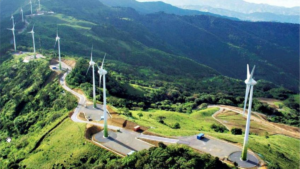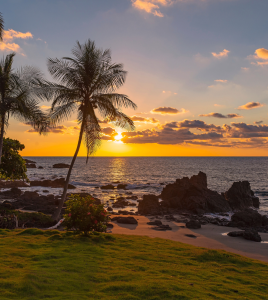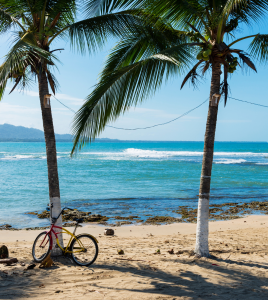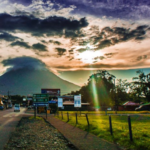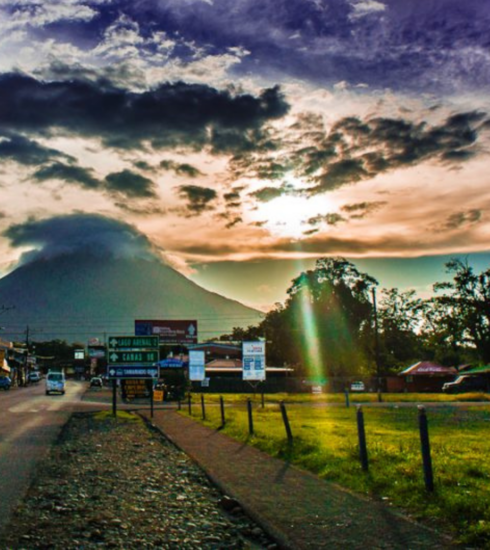Costa Rica Weather

Dry vs. Wet Seasons
Diverse and unique, in this small country you can experience over one dozen climatic zones with a variety of isolated micro-climates where temperatures fluctuate more according to location and elevation than by season; still, discomforting extremes are practically nonexistent.

- The dry season, or summer, in Costa Rica might be almost entirely without rainfall and runs opposite from North America and Europe, lasting from December to April.
- Winter/rainy season in Costa Rica is a lot less wet and rainy than many people assume, and generally lasts from May to November.
National Geographic lists Costa Rica as having one of the best climates in the world.
Atenas is the city listed as having the best climate in the world, twice.
he central valley has an average temperature in the 70’s while highs and lows throughout the year can range from the 50’s on up to brief moments of temps in the 90’s. The average temperature varies approximately 10 degrees from one season to the other.
Learn MoreCoastal areas will experience higher temperatures than in the valley with an average in the 80’s occasionally reaching over a sweltering 100 degrees. No matter where you go in the country, locals will insist that their particular climate is the best climate in the country. Although the Northwestern province of Guanacaste and the Nicoya Peninsula are the hottest and dryest regions, humidity can reach 100% in other areas of the country, especially in what is determined as the wet lowlands (Caribbean and South Pacific). In general, the coastal plains are warm and tropical, mountainous regions are much cooler and the Central Plateau has a spring-like climate year-round, with little variation in temperature from month to month.
Costa Rica has two basic seasons, popularly known as summer and winter, better described as the dry season and rainy season, or for the tourism industry, high season and low season. The tourism industry in recent years has adopted the phrase “green season” in place of “rainy/low season” since at this time, the tropical rains replenishes nature itself with the vibrancy of infinite tones of wild and lively greens. Increasing numbers of travelers are realizing that the ‘low’ season is a wonderful time to visit, when prices go down and crowds are sparse.
The dry season, or summer, in Costa Rica might be almost entirely without rainfall and runs opposite from North America and Europe, lasting from December to April. Many travelers come to the country to escape the dark slush of northern hemisphere winters and squeeze in a few more hours of daylight. Sunrise and sunset vary little year around, and daylight hours extend generally from 5am to 6pm throughout the year. The dry season is a month or two shorter along the southern Pacific coast. July also tends to be a dry month on the Pacific slope
Winter/rainy season in Costa Rica is a lot less wet and rainy than many people assume, and generally lasts from May to November. Much of the country will receive impressive downpours in the early morning or afternoon, and the rest of the day receive brilliant sunshine. Folliage blooms like the best days of Spring, and the country becomes impressively green and lush. Many Costa Ricans prefer the early months of winter over any other time of year. Surf is at its best as storm swells in the Pacific create very attractive and reliable waves although, the rain is for the most part of the season only a drizzle or a passing shower to dampen the thirsty earth. Although the rainforest and cloudforests of Costa Rica will receive drenching rain during the green season, the beaches will continue to receive sunny weather. Other areas receive enormous amounts of rainfall during the depth of the rainy season, particularly the northeast and southwest. The Osa Peninsula, home to the largest tract of virgin low lying rainforest in Central America, receives such torrential downpours during September and October that reliable travel can become all but impossible, and many lodges will just close during those months. The Southern half of the Pacific is much wetter than the north, with a shorter dry season and longer and heavier afternoon rains in the wet season.
ANNUAL RAINFALL FOR MAJOR AREAS
| Region | Metric | Imperial |
|---|---|---|
| Central Valley | 1.100-2.500 mm | 43-98 inches |
| Norther Pacific | 1.400-4.300 mm | 55-98 inches |
| Central Pacific | 2.300-4.300 mm | 91-169 inches |
| Southern Pacific | 2.300-4.000 mm | 91-157 inches |
| Atlantic Region | 2.000-4.500 mm | 79-177 inches |


